20.3 Sensory Interaction
20-
Our senses—
270

Are you wondering how researchers test these kinds of questions? Try LaunchPad’s How Would You Know If a Cup of Coffee Can Warm Up Relationships?
Thus, to savor a taste, we normally breathe the aroma through our nose—
Vision and hearing may similarly interact. A weak flicker of light that we have trouble perceiving becomes more visible when accompanied by a short burst of sound (Kayser, 2007). And a sound may be easier to hear with a visual cue. If I [DM], as a person with hearing loss, watch a video with simultaneous captioning, I have no trouble hearing the words I am seeing. I may therefore think I don’t need the captioning, but if I then turn off the captioning, I suddenly realize I do need it. The eyes guide the ears (FIGURE 20.12).
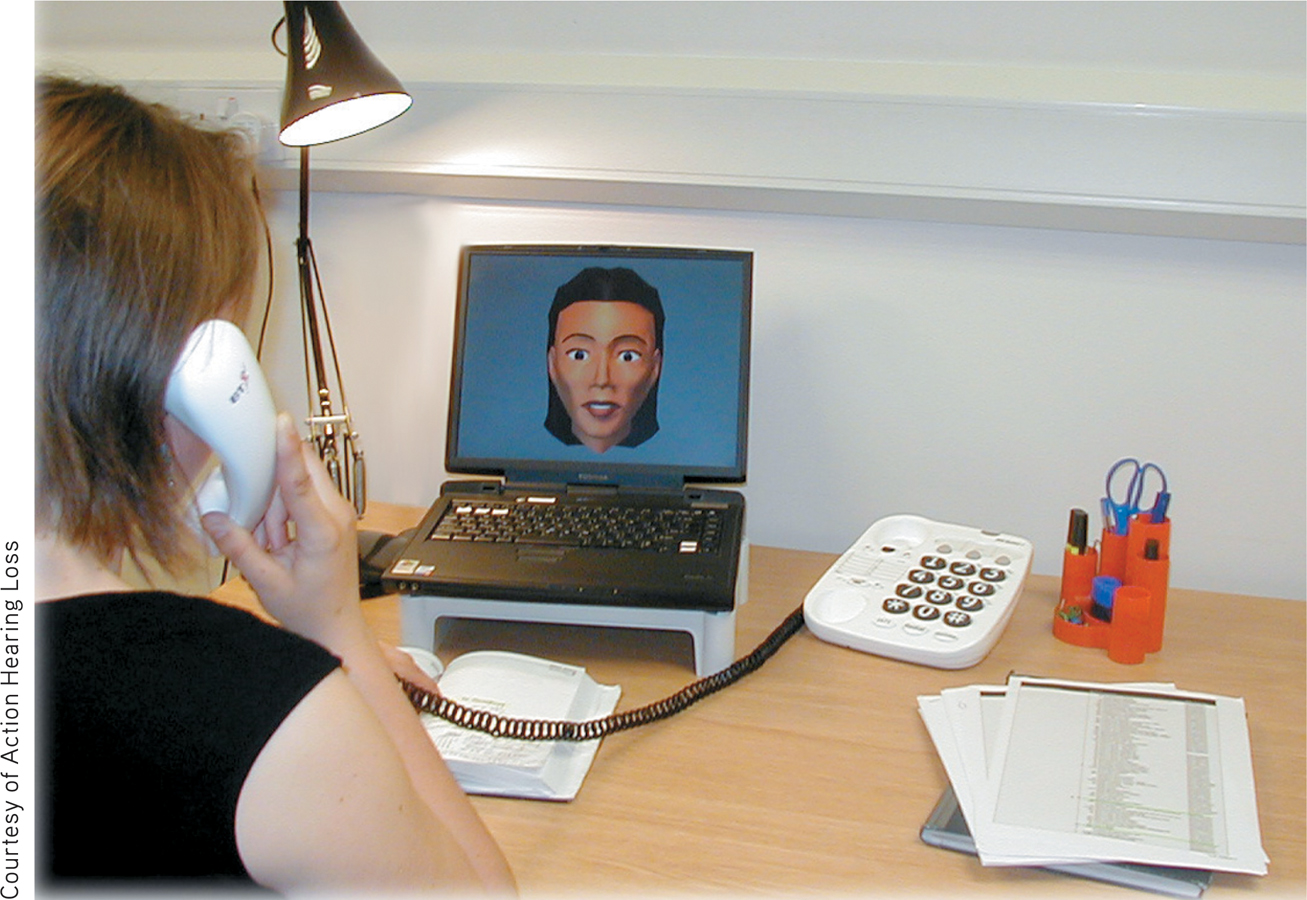
 Figure 20.12
Figure 20.12Sensory interaction When a hard-
But what do you suppose happens if the eyes and the ears disagree? What if we see a speaker saying one syllable while we hear another? Surprise: We may perceive a third syllable that blends both inputs. Seeing the mouth movements for ga while hearing ba we may perceive da. This phenomenon is known as the McGurk effect, after its discoverers, Scottish psychologist Harry McGurk and his assistant John MacDonald (1976). For all of us, lip reading is part of hearing.
Touch also interacts with our other senses. In detecting events, the brain can combine simultaneous touch and visual signals, thanks to neurons projecting from the somatosensory cortex back to the visual cortex (Macaluso et al., 2000). Touch even interacts with hearing. One experiment blew a puff of air (such as our mouths produce when saying pa and ta) on the neck or hands as people heard either these sounds or the more airless sounds ba or da. The result? People more often misheard ba or da as pa or ta when played with the faint puff (Gick & Derrick, 2009). Thanks to sensory interaction, they heard with their skin.
Our brain even blends our tactile and social judgments, as demonstrated in these playful experiments:
- After holding a warm drink rather than a cold one, people were more likely to rate someone more warmly, feel closer to them, and behave more generously (IJzerman & Semin, 2009; Williams & Bargh, 2008). Physical warmth promotes social warmth.
- After being given the cold shoulder by others in an experiment, people judge the room as colder than do those treated warmly (Zhong & Leonardelli, 2008). Social exclusion literally feels cold.
- Sitting at a wobbly desk and chair makes others’ relationships seem less stable (Kille et al., 2013).
- When leaning to the left—by sitting in a left-rather than right-leaning chair, or squeezing a handgrip with their left hand, or using a mouse with their left hand—people lean more left in their expressed political attitudes (Oppenheimer & Trail, 2010). When holding a soft ball, American students become more likely to categorize a face as a Democrat rather than a Republican, and vice versa when holding a hard ball (Slepian et al., 2012).
271
These examples of embodied cognition illustrate how brain circuits processing bodily sensations connect with brain circuits responsible for cognition. We think from within a body.
So, the senses interact: As we attempt to decipher our world, our brain blends inputs from multiple channels. For many people, an odor, perhaps of mint or chocolate, can evoke a sensation of taste (Stevenson & Tomiczek, 2007). But in a few select individuals, the senses become joined in a phenomenon called synesthesia, where one sort of sensation (such as hearing sound) involuntarily produces another (such as seeing color). Early in life, “exuberant neural connectivity” produces some arbitrary associations among the senses, which later are normally—
For a summary of our sensory systems, see TABLE 20.2. The river of perception is fed by sensation, cognition, and emotion. And that is why we need biological, psychological, and social-
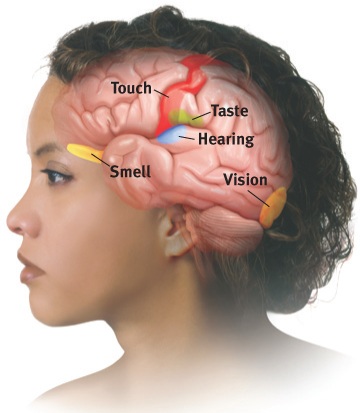
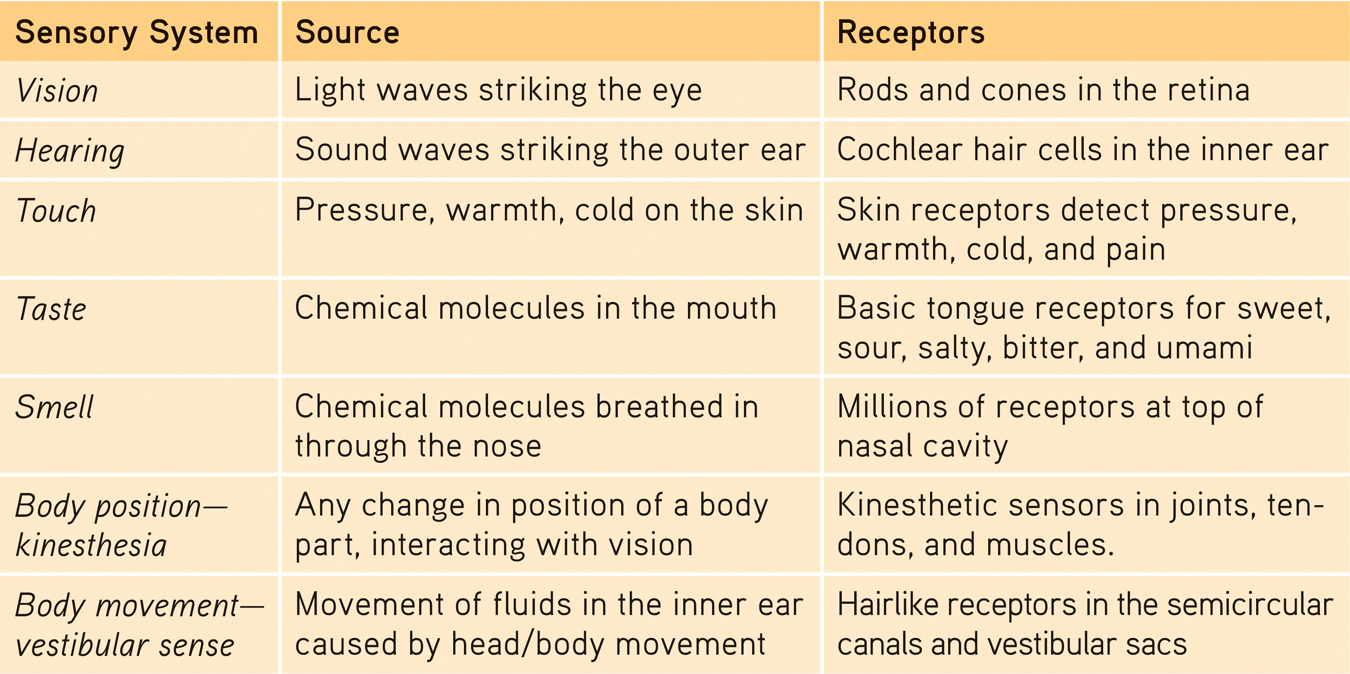
 Table 20.2
Table 20.2Summarizing the Senses
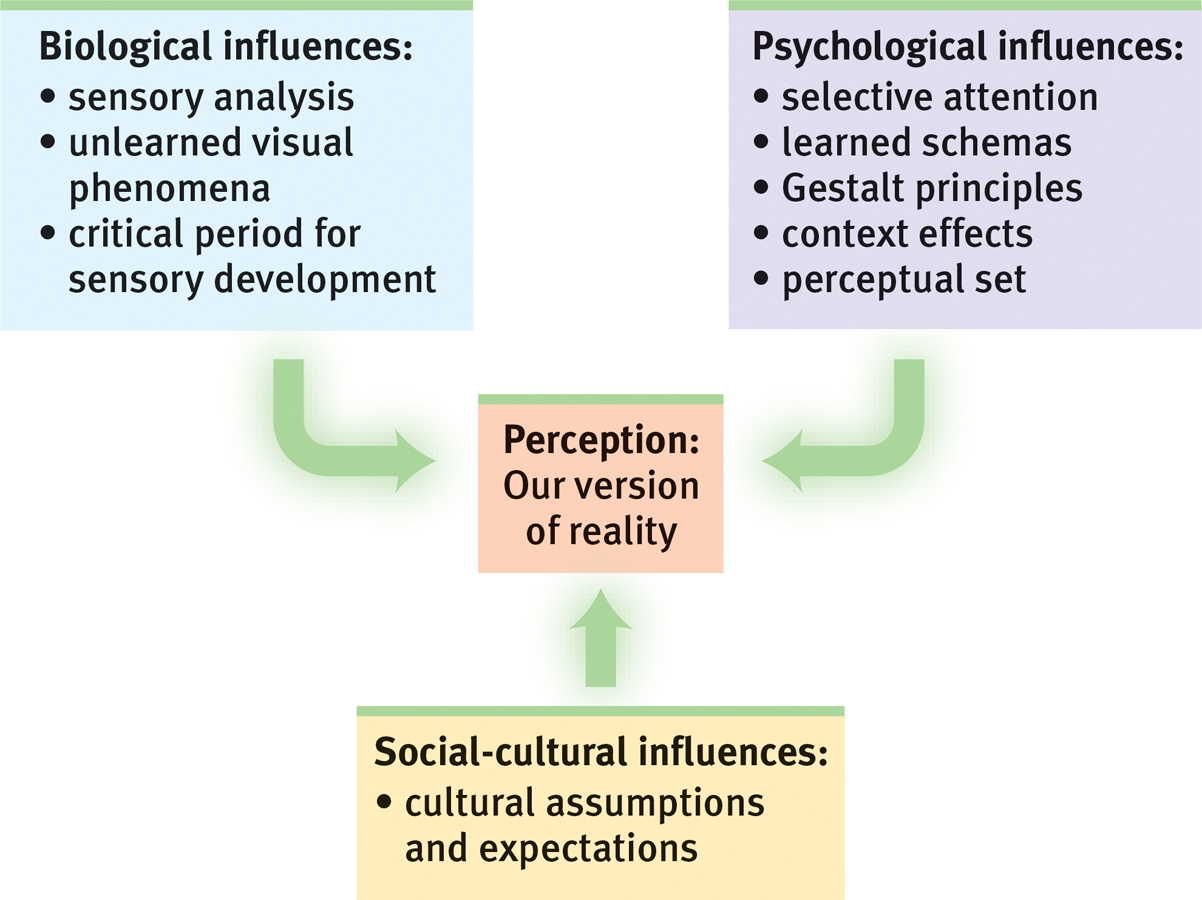
 Figure 20.13
Figure 20.13Perception is a biopsychosocial phenomenon Psychologists study how we perceive with different levels of analysis, from the biological to the social-
If perception is the product of these three sources, what can we say about extrasensory perception, which claims that perception can occur apart from sensory input? For more on that question, see Thinking Critically About: ESP—
***
To feel awe, mystery, and a deep reverence for life, we need look no further than our own perceptual system and its capacity for organizing formless nerve impulses into colorful sights, vivid sounds, and evocative smells. As Shakespeare’s Hamlet recognized, “There are more things in Heaven and Earth, Horatio, than are dreamt of in your philosophy.” Within our ordinary sensory and perceptual experiences lies much that is truly extraordinary—
272
THINKING CRITICALLY ABOUT
THINKING CRITICALLY ABOUT: ESP—Perception Without Sensation?
20-9 What are the claims of ESP, and what have most research psychologists concluded after putting these claims to the test?
Without sensory input, are we capable of extrasensory perception (ESP)? Are there indeed people—
The most testable and, for this discussion, most relevant ESP claims are
- telepathy: mind-to-mind communication.
- clairvoyance: perceiving remote events, such as a house on fire in another state.
- precognition: perceiving future events, such as an unexpected death in the next month.
Closely linked is psychokinesis, or “mind over matter,” such as levitating a table or influencing the roll of a die. (The claim is illustrated by the wry request, “Will all those who believe in psychokinesis please raise my hand?”)
If ESP is real, we would need to overturn the scientific understanding that we are creatures whose minds are tied to our physical brains and whose perceptual experiences of the world are built of sensations. Sometimes new evidence does overturn our scientific preconceptions. Science, as we will see throughout this book, offers us surprises—
Most research psychologists and scientists are skeptical that paranormal phenomena exist. But reputable universities in Great Britain, the Netherlands, and Australia, have added faculty chairs or research units in parapsychology (Storm, 2010a,b; Turpin, 2005). These researchers perform scientific experiments searching for possible ESP and other paranormal phenomena. Before seeing how parapsychologists do research on ESP, let’s consider some popular beliefs.
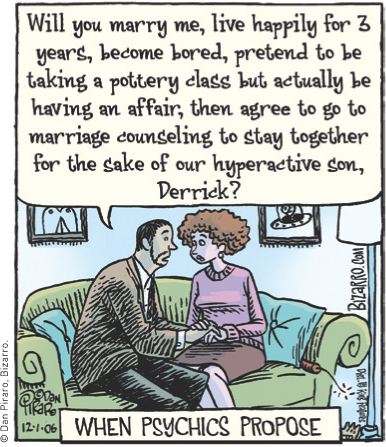
Premonitions or Pretensions?
Can psychics see into the future? Although one might wish for a psychic stock forecaster, the tallied forecasts of “leading psychics” reveal meager accuracy. During the 1990s, the tabloid psychics were all wrong in predicting surprising events. (Madonna did not become a gospel singer, the Statue of Liberty did not lose both its arms in a terrorist blast, Queen Elizabeth did not abdicate her throne to enter a convent.) And the psychics have missed recent big-
After Amanda Berry went missing in Cleveland in 2003, her distraught and desperate mother turned to a famed psychic on a national television show for answers. “She’s not alive, honey,” the psychic told the devastated mom, who died without living to see her daughter rescued in 2013 (Radford, 2013). According to one analysis, this result brought that psychic’s record on 116 missing person and death cases to 83 unknown outcomes, 33 incorrect, and zero mostly correct. To researcher Ryan Shaffer (2013), that’s the record of a “psychic defective.”
The psychic visions offered to police departments have been no more accurate than guesses made by others (Nickell, 1994, 2005; Radford, 2010; Reiser, 1982). But their sheer volume does increase the odds of an occasional correct guess, which psychics can then report to the media. Police departments are wise to all this. When researchers asked the police departments of America’s 50 largest cities whether they ever had used psychics, 65 percent said No (Sweat & Durm, 1993). Of those that had, not one had found them helpful.
Psychics’ vague predictions sometimes sound correct when later interpreted (“retrofitted”) to match events that provide a perceptual set for “understanding” them. Nostradamus, a sixteenth-
273
Are the spontaneous “visions” of everyday people any more accurate? Do dreams, for example, foretell the future, as people from both Eastern and Western cultures tend to believe—
Given the billions of events in the world each day, and given enough days, some stunning coincidences are sure to occur. By one careful estimate, chance alone would predict that more than a thousand times a day someone on Earth will think of another person and then within the next five minutes will learn of that person’s death (Charpak & Broch, 2004). Thus, when explaining an astonishing event, we should “give chance a chance” (Lilienfeld, 2009). With enough time and people, the improbable becomes inevitable.
Putting ESP to Experimental Test
When faced with claims of mind reading or out-
This scientific attitude has led both believers and skeptics to agree that what parapsychology needs is a reproducible phenomenon and a theory to explain it. Parapsychologist Rhea White (1998) spoke for many in saying that “the image of parapsychology that comes to my mind, based on nearly 44 years in the field,
“To be sure of hitting the target, shoot first and call whatever you hit the target.”
Writer-
“A person who talks a lot is sometimes right.”
Spanish proverb
is that of a small airplane [that] has been perpetually taxiing down the runway of the Empirical Science Airport since 1882 … its movement punctuated occasionally by lifting a few feet off the ground only to bump back down on the tarmac once again. It has never taken off for any sustained flight.”
How might we test ESP claims in a controlled, reproducible experiment? An experiment differs from a staged demonstration. In the laboratory, the experimenter controls what the “psychic” sees and hears. On stage, the psychic controls what the audience sees and hears.
The search for a valid and reliable test of ESP has resulted in thousands of experiments. After digesting data from 30 such studies, parapsychologist Lance Storm and his colleagues (2010a,b; 2013) concluded that, given participants with experience or belief in ESP, there is “consistent and reliable” parapsychological evidence. Psychologist Ray Hyman (2010), who has been scrutinizing parapsychological research since 1957, replied that if this is the best evidence, it fails to impress: “Parapsychology will achieve scientific acceptability only when it provides a positive theory with … independently replicable evidence. This is something it has yet to achieve after more than a century.”
Daryl Bem (2011), a respected social psychologist, has been a skeptic of stage psychics; he once quipped that “a psychic is an actor playing the role of a psychic” (1984). Yet he reignited hopes for replicable evidence with nine experiments that seemed to show people anticipating future events. In one, when an erotic scene was about to appear on a screen in one of two randomly selected positions, Cornell University participants guessed right 53.1 percent of the time (beating 50 percent by a small but statistically significant margin). In another, people viewed a set of words, took a recall test of those words, and then rehearsed a randomly selected subset of those words. People better remembered the rehearsed words—
Bem wonders if his “anomalous” findings reflect an evolutionary advantage to those who can precognitively anticipate future dangers. Critics scoff. “If any of his claims were true,” wrote cognitive scientist Douglas Hofstadter (2011), “then all of the bases underlying contemporary science would be toppled, and
“At the heart of science is an essential tension between two seemingly contradictory attitudes—
Carl Sagan (1987)
274
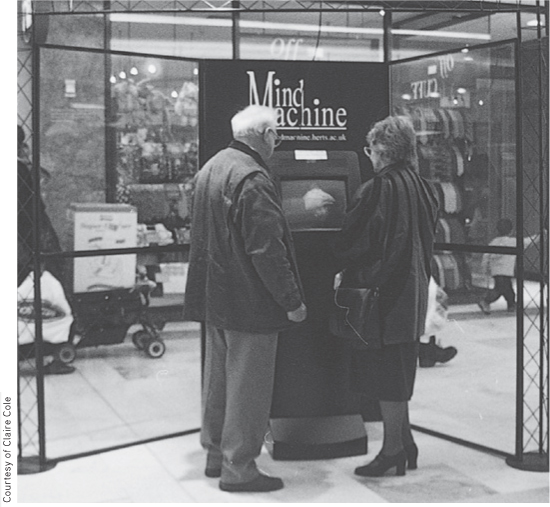
we would have to rethink everything about the nature of the universe.” Moreover, if future events retroactively affect present feelings, then why can’t people intuitively predict casino outcomes or stock market futures?
Despite the paper having survived critical reviews by a top-
Anticipating such skepticism, Bem has made his computer materials available to anyone who wishes to replicate his studies. Multiple attempts have since been made, without success (Galak et al., 2012; Ritchie et al., 2012). Regardless, science is doing its work. It has been open to a finding that challenges its own assumptions. And then, through follow-
One skeptic, magician James Randi, has had a longstanding offer of $1 million to be given “to anyone who proves a genuine psychic power under proper observing conditions” (Randi, 1999; Thompson, 2010). French, Australian, and Indian groups have made similar offers of up to 200,000 euros (CFI, 2003). Large as these sums are, the scientific seal of approval would be worth far more. To refute those who say there is no ESP, one need only produce a single person who can demonstrate a single, reproducible ESP event. (To refute those who say pigs can’t talk would take but one talking pig.) So far, no such person has emerged.
RETRIEVAL PRACTICE
- If an ESP event occurred under controlled conditions, what would be the next best step to confirm that ESP really exists?
The ESP event would need to be reproduced in other scientific studies.
275